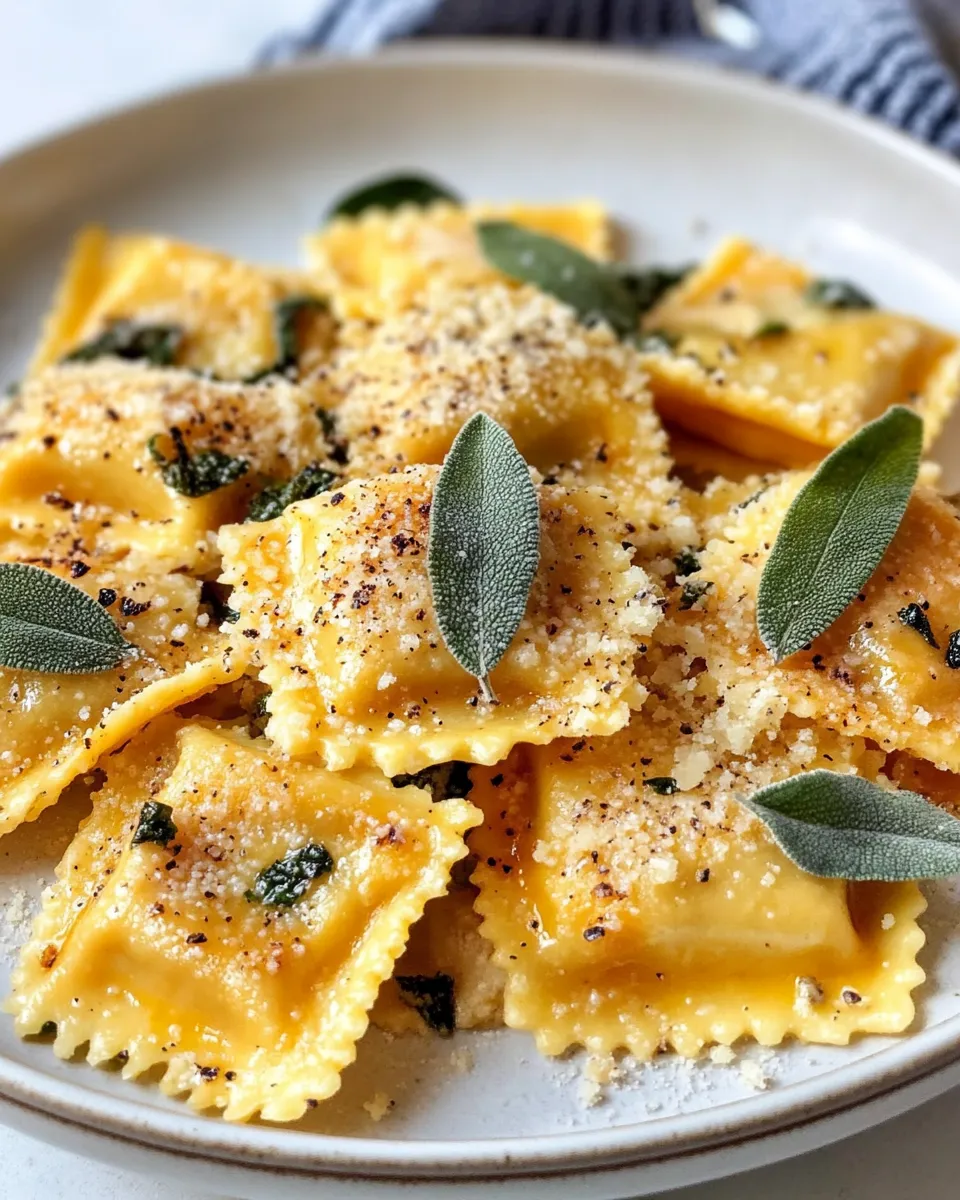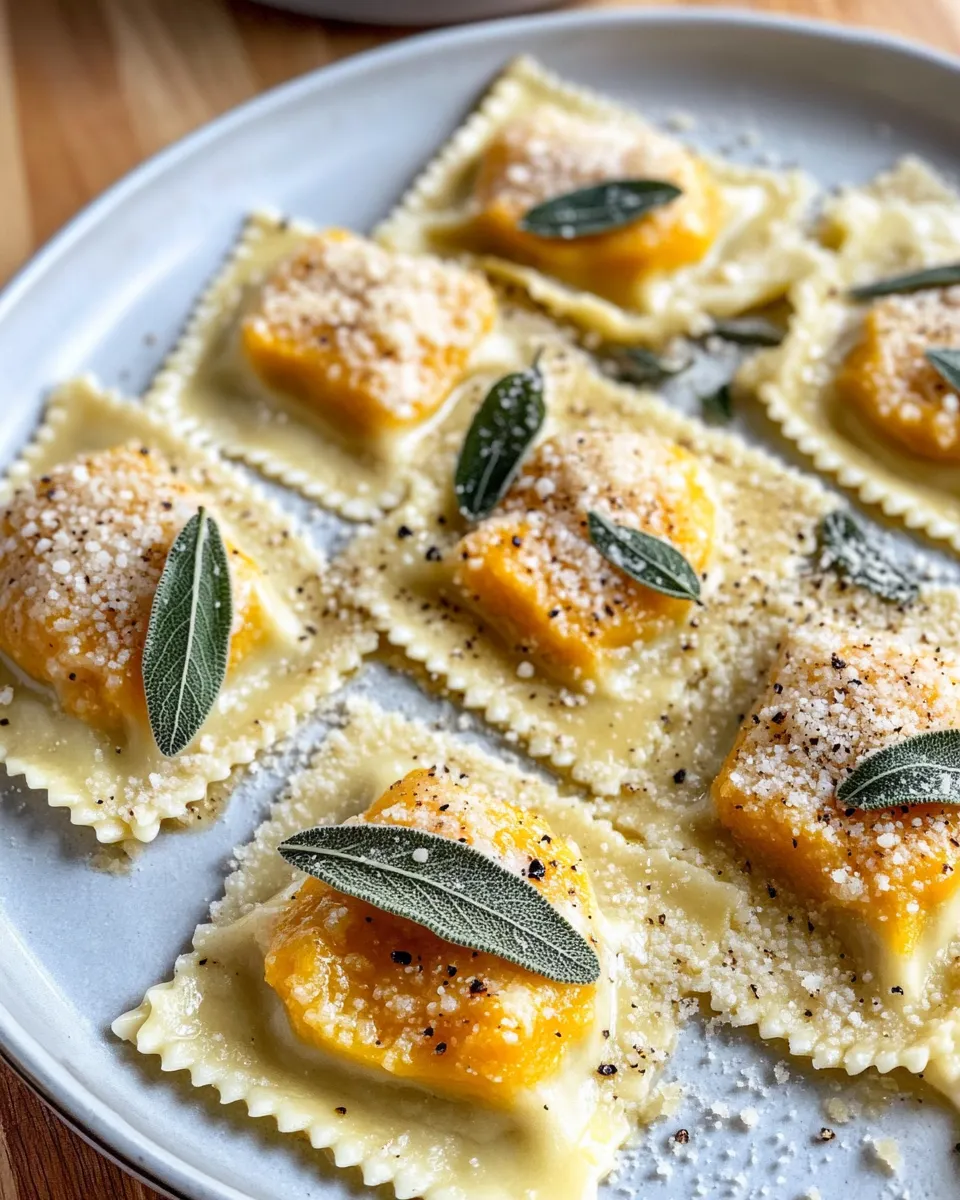
There’s something truly magical about homemade pasta, especially when it’s filled with the sweet, velvety flavor of roasted butternut squash. This Butternut Squash Ravioli with Browned Butter Sage (No Wine) recipe brings together a cozy, comforting filling wrapped in delicate pasta dough, finished with a nutty browned butter sauce infused with fresh sage leaves. It’s a stunning dish that feels elegant yet approachable—a perfect way to impress guests or treat yourself on a chilly evening. Plus, this recipe skips the wine but keeps all the richness and depth you crave. Let’s dive into this delicious experience!
What You’ll Love About This Recipe

- Rich, creamy filling: Roasted butternut squash pureed with ricotta and Parmesan creates a luscious, flavorful center.
- Homemade pasta dough: Simple ingredients come together to make fresh, tender ravioli that melt in your mouth.
- No wine needed: The browned butter sage sauce delivers a deep, aromatic flavor without any alcohol.
- Seasonal and comforting: Perfect for fall and winter dinners, bringing warmth and seasonal goodness to your table.
- Impressively elegant: This recipe looks gourmet but is actually easy enough for a weekend cooking adventure.
Shopping List
- 2 cups butternut squash (peeled, cubed, and roasted)
- 1 cup ricotta cheese
- 1/2 cup grated Parmesan cheese
- 1 large egg
- 1 teaspoon salt
- 1/2 teaspoon black pepper
- 1/4 teaspoon ground nutmeg
- 2 cups all-purpose flour
- 1/2 teaspoon olive oil
- 1/2 cup unsalted butter
- 10 fresh sage leaves
What You’ll Need (Gear)
- Baking sheet: For roasting the butternut squash cubes evenly.
- Food processor or blender: To puree the roasted squash smoothly.
- Mixing bowls: For combining filling and dough ingredients.
- Rolling pin or pasta machine: To roll out the pasta dough thinly.
- Ravioli mold or cookie cutter: For shaping the ravioli (optional but helpful).
- Large pot: To boil water for cooking the ravioli.
- Skillet: To brown the butter and crisp the sage leaves.
- Slotted spoon: To remove ravioli from boiling water carefully.
Butternut Squash Ravioli with Browned Butter Sage (No Wine): Step-by-Step Guide

Step 1: Roast the Butternut Squash
Preheat your oven to 400°F (200°C). Toss the peeled and cubed butternut squash with a drizzle of olive oil and a pinch of salt. Spread evenly on a baking sheet and roast for about 25-30 minutes until tender and caramelized on the edges. Let it cool slightly before transferring to a food processor.
Step 2: Prepare the Filling
In the food processor, puree the roasted squash until smooth. Transfer to a bowl and mix in ricotta cheese, grated Parmesan, egg, salt, black pepper, and nutmeg. Stir until well combined. Set the filling aside while you prepare the pasta dough.
Step 3: Make the Pasta Dough
On a clean surface, mound the flour and create a well in the center. Crack the egg into the well and add olive oil and a pinch of salt. Slowly mix the egg into the flour using your fingers or a fork, gradually incorporating more flour until a dough forms. Knead the dough for about 8-10 minutes until smooth and elastic. Wrap it in plastic wrap and let it rest for at least 30 minutes.
Step 4: Roll Out the Dough
Divide the dough into two portions. Using a rolling pin or pasta machine, roll each portion into thin sheets about 1/16 inch thick. Dust with flour to prevent sticking.
Step 5: Assemble the Ravioli
Place small spoonfuls (about 1 teaspoon) of filling spaced evenly on one sheet of pasta. Lightly brush water around each mound to help seal. Carefully lay the second sheet of dough over the top. Press around the filling to seal, making sure to remove any air pockets. Cut into individual ravioli squares using a knife, pizza cutter, or ravioli mold.
Step 6: Cook the Ravioli
Bring a large pot of salted water to a gentle boil. Add the ravioli in batches and cook for 3-4 minutes or until they float to the surface and are tender. Use a slotted spoon to transfer cooked ravioli to a serving dish.
Step 7: Make the Browned Butter Sage Sauce
In a skillet, melt the unsalted butter over medium heat. Continue cooking, swirling the pan occasionally, until the butter turns golden brown and smells nutty. Add fresh sage leaves and cook for about 1 minute until crispy and fragrant. Remove from heat.
Step 8: Serve
Drizzle the browned butter sage sauce over the cooked ravioli. Garnish with extra Parmesan cheese and freshly ground black pepper if desired. Serve immediately and enjoy the warm, comforting flavors.
How to Make It Lighter
- Use part-skim ricotta cheese instead of full-fat to reduce calories.
- Reduce the amount of butter in the sauce or replace half with olive oil.
- Omit the Parmesan or use a smaller amount to lower fat content.
- Serve smaller portions alongside a fresh green salad or steamed vegetables for a balanced meal.
Steer Clear of These
- Using canned butternut squash—fresh roasting gives the best flavor and texture.
- Overfilling the ravioli, which can cause them to burst during cooking.
- Boiling the ravioli too vigorously; a gentle simmer will keep them intact.
- Skipping the resting period for the dough, which is crucial for elasticity and easy rolling.
Cooling, Storing & Rewarming
If you want to prepare the ravioli ahead of time, place them on a floured baking sheet in a single layer to prevent sticking. Refrigerate for up to 24 hours before cooking. For longer storage, freeze the uncooked ravioli on the baking sheet until firm, then transfer to a sealed container or bag for up to 2 months.
To reheat cooked ravioli, gently warm them in a skillet with a little butter or olive oil, or briefly dip them in simmering water until heated through. Avoid microwaving as it can make the pasta rubbery.
Butternut Squash Ravioli with Browned Butter Sage (No Wine) Q&A
Can I make the pasta dough ahead of time?
Absolutely! You can make the dough up to 24 hours in advance. Just wrap it tightly in plastic wrap and refrigerate. Let it come to room temperature before rolling out for easier handling.
What if I don’t have fresh sage?
Fresh sage is ideal for the browned butter sauce because it crisps nicely and adds a fragrant aroma. If unavailable, you can use dried sage, but add it sparingly at the end of cooking to avoid bitterness.
How do I know when the ravioli are done cooking?
Ravioli are typically done when they float to the surface of the boiling water and then cook for an additional 1-2 minutes. The pasta should be tender but not mushy, and the filling heated through.
Can I substitute the butternut squash with something else?
Yes! Sweet potatoes or pumpkin puree make excellent alternatives, offering a similar sweetness and texture. Just roast and puree them the same way as the butternut squash.
See You at the Table
This Butternut Squash Ravioli with Browned Butter Sage (No Wine) is a celebration of simple ingredients elevated by thoughtful preparation. Whether it’s a special occasion or a weekend treat, this recipe brings warmth, flavor, and a touch of elegance to your plate. I hope you enjoy making it as much as you enjoy eating it. Grab your apron, roll up your sleeves, and get ready for some seriously delicious homemade pasta magic. See you at the table!
Share on Pinterest


Butternut Squash Ravioli with Browned Butter Sage (No Wine)
Ingredients
Equipment
Method
- Preheat your oven to 400°F (200°C). Toss the peeled and cubed butternut squash with a drizzle of olive oil and a pinch of salt. Spread evenly on a baking sheet and roast for about 25-30 minutes until tender and caramelized on the edges. Let it cool slightly before transferring to a food processor.
- In the food processor, puree the roasted squash until smooth. Transfer to a bowl and mix in ricotta cheese, grated Parmesan, egg, salt, black pepper, and nutmeg. Stir until well combined. Set the filling aside while you prepare the pasta dough.
- On a clean surface, mound the flour and create a well in the center. Crack the egg into the well and add olive oil and a pinch of salt. Slowly mix the egg into the flour using your fingers or a fork, gradually incorporating more flour until a dough forms. Knead the dough for about 8-10 minutes until smooth and elastic. Wrap it in plastic wrap and let it rest for at least 30 minutes.
- Divide the dough into two portions. Using a rolling pin or pasta machine, roll each portion into thin sheets about 1/16 inch thick. Dust with flour to prevent sticking.
- Place small spoonfuls (about 1 teaspoon) of filling spaced evenly on one sheet of pasta. Lightly brush water around each mound to help seal. Carefully lay the second sheet of dough over the top. Press around the filling to seal, making sure to remove any air pockets. Cut into individual ravioli squares using a knife, pizza cutter, or ravioli mold.
- Bring a large pot of salted water to a gentle boil. Add the ravioli in batches and cook for 3-4 minutes or until they float to the surface and are tender. Use a slotted spoon to transfer cooked ravioli to a serving dish.
- In a skillet, melt the unsalted butter over medium heat. Continue cooking, swirling the pan occasionally, until the butter turns golden brown and smells nutty. Add fresh sage leaves and cook for about 1 minute until crispy and fragrant. Remove from heat.
- Drizzle the browned butter sage sauce over the cooked ravioli. Garnish with extra Parmesan cheese and freshly ground black pepper if desired. Serve immediately and enjoy the warm, comforting flavors.
Notes
- Store uncooked ravioli on a floured baking sheet and refrigerate for up to 24 hours or freeze for up to 2 months.
- Use part-skim ricotta or reduce butter for a lighter version.
- Fresh sage crisps nicely in browned butter; dried sage can be used sparingly if needed.






